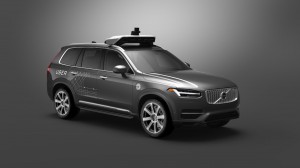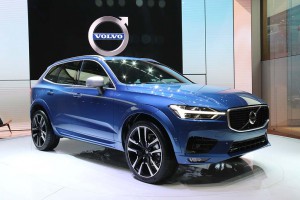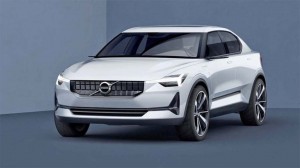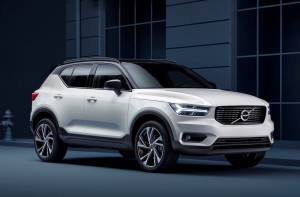Volvo took a lead in the push into electrification last year, announcing it would use some of battery-based drive system on all future products, whether mild, conventional or plug-in hybrids, or pure battery-electric. And, last January, it gave us a hint of what that first BEV would be with the debut of its 40.2 concept.
The production version will follow in 2019 and, if Volvo’s latest forecast is any indication, so will plenty of other all-electric models, as the Swedish automaker now says it wants them to generate half of its sales by mid-decade.
The mid-term plan Volvo is laying out is nothing if not ambitious. It also predicts that half of the Chinese-owned automaker’s sales will come from self-driving vehicles, and that half of its volume will come through its Care by Volvo subscription service, rather than conventional sales and leasing. Oh, and add a goal of boosting volume – and profitability – to match other premium manufacturers.
“Our customers’ expectations are changing rapidly. This means that Volvo Cars is also changing rapidly. These initiatives will help transform Volvo from being purely a car company to being a direct consumer services provider,” said the carmaker’s President and CEO Hakan Samuelsson.
Since being sold by Ford Motor Co. to Zhejiang Geely eight years ago, Volvo has aggressively sought to carve out its own course. It has not only completely made over its vehicle line-up but radically revised what goes under the hood of those vehicles. Its first step was to go to an “all-four” strategy, abandoning the V-8s and V-12s – and even turbo-sixes then considered the hallmark of a luxury brand, in favor of variations on the four-cylinder theme.
Currently, its line—up includes the base T5 and more powerful T6 engines, as well as the “Twin-Engine” T8 which combines a four-cylinder gas engine that is both turbo and supercharged with a plug-in hybrid driveline that, in its newest entry, the V60 wagon, makes 400 horsepower.
It also offers diesels, though Volvo officials have made it clear that they will be phased out soon, as the company shifts to an all-electrified driveline that should match or exceed the efficiency of traditional “oil-burners.”
(Volvo cutting diesel engines from portfolio. Click Here for the story.)
One thing that Volvo hasn’t shifted away from is its traditional focus on safety – though it has had to work harder to try to stay ahead in an industry where digital technology means breakthroughs often come from creative use of software rather than traditional mechanical ingenuity.

Volvo has been working with Uber on autonomous vehicles but also has its own, independent program underway.
That push has made Volvo emphasize autonomous driving, both on its own and with partners like Uber. That particular tie-up proved embarrassing when a modified XC90 hit and killed a pedestrian near Phoenix earlier this year – though it now appears Uber actually disabled Volvo technology that could have prevented, or at least reduced the severity of, the crash.
Some Volvo insiders tell TheDetroitBureau.com they are sometimes surprised by the degree of freedom they have had since the Geely acquisition. But others say they’re not surprised, since the Swedish-based automaker is essentially serving as the tip of the spear for an ambitious Chinese company that sees it as the way to globalize its broader line-up.
Volvo platforms and technologies are already helping improve the quality and appeal of vehicles sold by the Geely brand, as well as its new, more upscale Lynk & Co. brand. There’s also Polestar, the one-time racing and tuner company that is now becoming a Volvo sub-brand focused on high-performance electrified vehicles, such as the new Polestar 1 plug-in hybrid.
(For more on Geely’s global ambitions, Click Here.)
Volvo, itself, is planning to add significantly more products to its line-up in the coming years. But the maker stresses that it won’t develop unique platforms for its future BEV models. Instead, its two platforms, such as the SPA, or Scalable Product Architecture use for the 60 and 80 lines, is flexible enough to accommodate a variety of different-sized battery packs in its floor.

The Volvo XC60 was named North American Utility Vehicle of the Year in 2018, the brand's second win.
The way Volvo is marketing its products has also been changing, starting with the launch of the new Care by Volvo program. Making its debut with the XC40 model, it allows motorists to sign up for two years essentially worry-free, said Jim Nichols, a company product spokesman, as it covers “everything but the gas you use.” Even taxes, fees and insurance are rolled in.
Currently, the program is not quite as flexible as subscription services offered by such luxury competitors as Cadillac and Porsche, who allow a customer to swap between different models, as the need arises. But that feature could be added later, according to Volvo.
All this, said Samuelsson, “paves the way for Volvo Cars to continue growing fast into the middle of the next decade.” The company, he added, ” has been transformed since 2010 into a global premium car company. Now it is time for this transformation to be turned into a period of sustained profitability in line with other premium brands.”
The good news for Volvo is after faltering under Ford and continuing to lose momentum in the early years under Geely, it has begun a noticeable turnaround. It achieved global sales of 571,577 vehicles last year, a record. So far this year, demand in the U.S., one of its two largest markets, has jumped 40.9 percent.
Earnings also set a record. The Geely subsidiary reported a 27.7% increase in its operating profit for 2017, at 7.96 billion Swedish kronor, or $911 million at the current exchange rate. Margins also rose to 6.7% last year from 6.1% in 2016. That’s well behind industry leaders, but Samuelsson appears confident that will be rising even faster through the middle of the coming decade.
(Volvo moves to eliminate plastic waste. Click Here for the story.)


